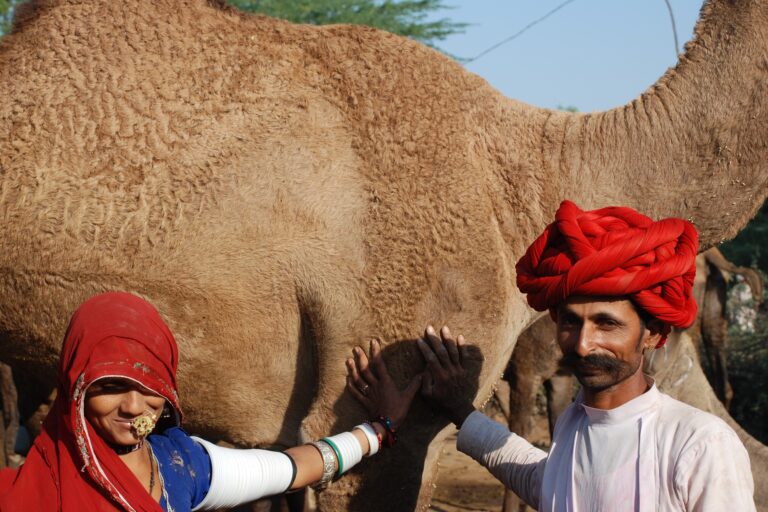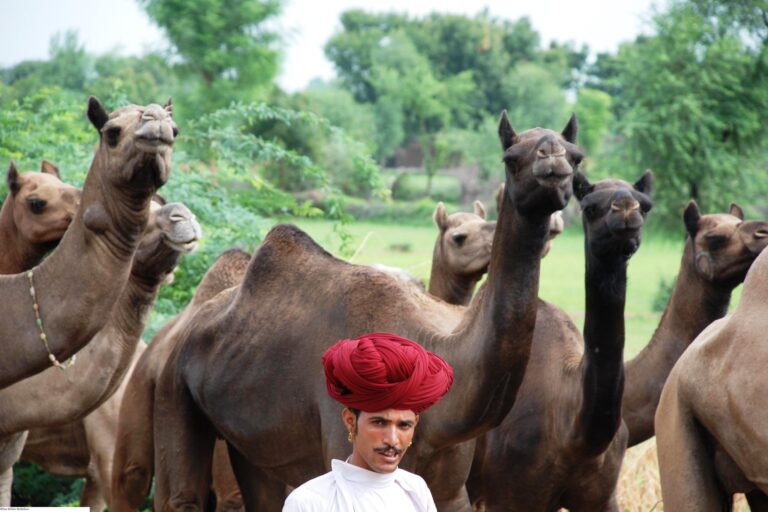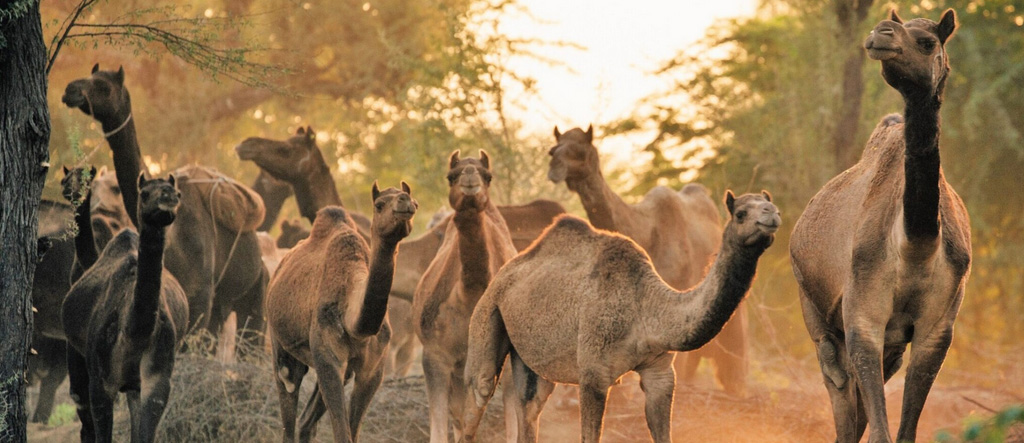Articles
‘Rescuing’ camels not a solution; Rajasthan needs sanctuaries for its state animal
- Rajasthan’s camels are regularly being rescued from slaughter, but this only increases their suffering, as it involves no long-term solution.
- Camels need protected grazing areas where they can feed on native vegetation. Such camel sanctuaries would serve as biodiversity hotspots and conserve other native drought adapted animal and plant species as well.
- The International Year of Camelids in 2024 provides a window of opportunity for rekindling Rajasthan’s camel heritage by setting up a network of camel sanctuaries that could turn into a major tourist attraction and secure rural livelihoods.
On May 3, this year, 111 camels from Rajasthan were ‘rescued’ from presumed slaughter as they were passing through Nasik in Maharashtra. Authorities confiscated the animals and put them into a gaushala, or cow shelter. But camels are not cows and do not do well in such shelters: as desert animals, they are habituated to moving around freely and browsing on thorny acacia trees, rather than being confined and stall-fed. While the rescuers were trying to sort out what to do with them next, the camels lost condition and fell victim to mange, a parasitic skin disease that spreads rapidly when camels are crowded together, causes extreme discomfort, and can lead to death. By the time it had been arranged for a group of Raika camel experts from Rajasthan to come to Maharashtra and walk the camels back home, several had already died and the remainder was in pitiful, emaciated condition. As the caravan of long-suffering camels moves towards Rajasthan, more of them are losing their will to live, refuse to walk on and die. It is heart-breaking to watch these dignified animals that keep walking until fatal exhaustion sets in, perish one after the other.
Moreover, it is uncertain what fate waits await the surviving animals once they have reached Rajasthan. Who is going to take care of them and where is sufficient space for them to safely roam? For the well-being of camels, it is essential that they have room to move and have access to some of the more than 36 different trees and shrubs that compose their natural diets. That is what the Raika say. They are Rajasthan’s hereditary camel herders who have bred and managed these animals since generations and who have a treasure trove of knowledge for keeping them hale and healthy. This community traditionally felt responsible for the welfare of the camel, believing their primeval ancestor was created by God Shiva for just that purpose.

Stories about camels being rescued from slaughter regularly surface in the media.
There is always a big self-congratulatory hullabaloo about saving the poor creatures from the butcher’s knife. Eventually, a wealthy donor is found who pays for trucking them back to Rajasthan ‘where they belong’. But as soon as the camels are out of eyesight of the rescuers and have reached Rajasthan, nobody cares, and the problem is presumed to be solved. Yet, the suffering of the traumatised animals continues as it is difficult and expensive to care for them. In some cases, the salvaged camels are sold once again and sent on another trek south.
Unless the problem is solved at the root, camel ‘rescuing’ just supports an endless cycle of camel suffering and unintended cruelty. And the root problem is two-fold: on one hand, the Raika, the hereditary custodians of the camel, are no longer able to make a living from camel herding. Things started to become difficult for them in the 1990s when motorised transport and tractors became available, leading to a reduced demand for male camels. At the same time – and this is the second root problem – their ancestral grazing areas disappeared due to development, irrigation agriculture and forest conservation areas. These two factors – lack of income and vanishing of grazing areas – led to an exodus of young people from camel breeding and the unravelling of traditional ecological knowledge.
When the livestock census of 2012 revealed that the camel population had shrunk from over a million in the 1980s to around 300,000, the Rajasthan government realised that it was losing its signature animal. Aware that the Pushkar camel fair exerted a huge draw on international tourists, it declared the camel state animal in 2014, and subsequently enacted the Rajasthan Camel (Prohibition of Slaughter and Regulation of Temporary Migration or Export) Act, 2025 which prohibited not only slaughter but also prevented movement of camels across state borders. Alas, the well-intended move had the opposite effect, contributing further to the downward spiral of the camel population. Between 2012 and 2019, India’s camel numbers declined by an additional 37.1% to 2.5 lakh. And now, by 2023, insiders, such as Hanwant Singh Rathore, the secretary of the NGO Lokhit Pashu-Palak Sansthan that has been working with the Raika for close to three decades, estimates that there may be only 1.5 lakh camels left. As for the Pushkar fair, it no longer bears a resemblance to the camel fair of yore but has morphed into a horse fair.
Solve the problem from the root
The first step would be to earmark ‘camel sanctuaries’ – places that are protected from further development, where camels can roam around and forage safely. These would be areas where native trees that camels thrive on grow – such as khejri (Prosopis cineraria), bordi (Zizyphus nummularia), babool (Acacia nilotica) and other drought-adapted species. These places would not just be havens for camels but double up as biodiversity hotspots conserving Rajasthan’s desert fauna – jackals, wolves, foxes, gazelles and others. They would be veritable territories of life.
But differently from conventional conservation areas for wild animals, the camels would be utilised. After all, they have been domesticated for more than 4,000 years and been in a close relationship with humans. They would provide milk, wool, dung, and companionship. Camel milk is ascribed many healing qualities, fetching $20 per litre in international markets. It is also slowly growing a clientele in India that purchases it for health reasons, ranging from autism to cancer to diabetes. It is also useful for treating tuberculosis and anaemia which are widespread among the rural population.

The International Year of Camelids in 2024
2024 has been designated as the International Year of Camelids by the United Nations General Assembly catapulting this species into the limelight of international development.
The justification for this is that “the great potential offered by camelids will contribute to the fight against hunger (SDG 2), as well as helping to tackle extreme poverty (SDG 1). The optimization of the many qualities of camelids (meat, milk, fibre, means of transport) would also contribute to guaranteeing food security and nutrition, providing sustainable livelihoods, and promoting the inclusion of communities that benefit from these animals. The participation of women working with camelid fibres and involved in pastoral work is relatively high, which significantly encourages the empowerment of women (SDG 5). Camelids can clearly help promote the sustainable use of terrestrial ecosystems (SDG 15) and, therefore, combat desertification, halt and reverse land degradation and stem the loss of biological diversity.”

This should be the cue for Rajasthan to rekindle its camel related cultural heritage by setting up camel sanctuaries – dedicated areas for camel grazing that could serve as biodiversity hotspots, as dispensing points of camel milk, as places for watching herds of mother camels and their babies frolicking around and witnessing the intimate relationship between the Raika and the camels. The magic that the Pushkar Camel Fair once exerted could be reborn at a time when people desperately seek to reconnect with nature. It would be a win-win-win situation for camels, for the Raika and their traditional ecological knowledge, for local women and artisans to obtain income, and excellent promotion for Rajasthan as a tourist destination.
One thing is for sure: Just ‘rescuing’ camels is not a solution, and in fact may be more cruel than slaughtering them, as it condemns them to an extended period of suffering. If we genuinely care about camel welfare and do not just want to use them for publicity stunts, we need to find a way forward that respects the needs of these magnificent animals and revives their close relationship with humans.


